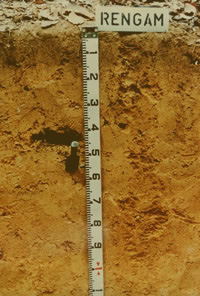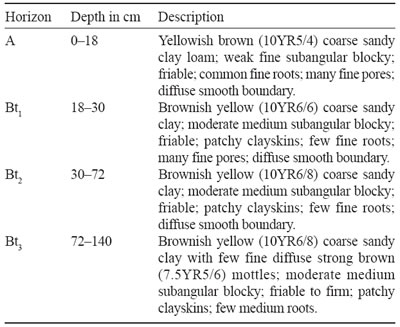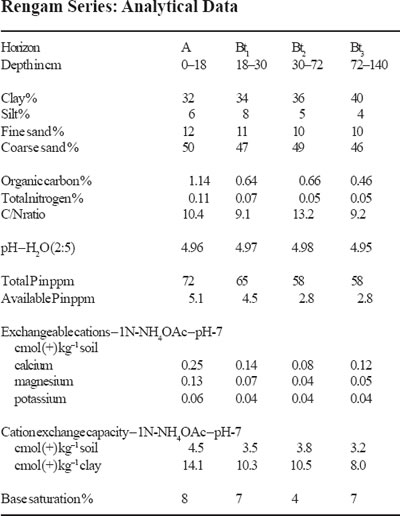Soil Profiles: Rengam
Rengam Series
The Rengam Series is a member of the Rengam Family which is a fine, kaolinitic, isohyperthermic, red-yellow Tipik Lutualemkuts. It typifies this family which is developed over coarse grained acid igneous rocks. The soils have a thin brown coarse sandy clay loam A horizons and deep uniform brownish yellow to yellowish brown coarse sandy clay to clay B horizons. The soils have moderately developed medium subangular blocky structures and friable consistence which gets firmer with depth. The soils occur on undulating, rolling and hilly terrain. They are derived from granitic parent material. Chemically these soils have a CECclay of less than 16 cmol (+) kg–1 clay in all subhorizons between 25 to 100 cm depth.
Type Location
The soils of the Rengam Series were first established in the Simpang Rengam area of Johore possibly by Owen or Jansen. The soil was subsequently described by Panton during the Reconnaissance Soil Survey of Terengganu. The above pedon was described in the Agricultural Museum, near Kuantan, Pahang on rolling terrain (16% slope) at an elevation of 50 m (150 feet). Location: Topographic Sheet 4360, 3°48′ N, 103°20′ E (Grid Reference 4360 – 930210 m).
Range in Characteristics
The A horizon of the Rengam Series is often a brown to dark brown (10YR4/ 3, 5/3) coarse sandy clay to coarse sandy clay loam. The B horizon are often uniform and deep. The colours in the B horizons are uniformly brownish yellow to yellowish brown (10YR6/8, 6/6, 5/6, 5/8), and strong brown (7.5YR5/6, 5/8). The textures in the B horizons range from coarse sandy clay through sandy clay to clay. The clay percentage ranges from 30 to 55% and seldom exceeds 60%. Invariably coarse sand dominates the sand fraction by a ratio of more than 3:1. The Rengam Series as mapped in the past had much wider range in properties and a coarse sandy type (actually gravelly type), a red variant and a clay type were also mapped. These are however now excluded from the Rengam Series. The Rengam Series as redefined here cannot have hues of 5YR or redder within the upper 50 cm (Rengam/red variant). The amount of gravels in the upper 50 cm cannot exceed 35% (Beserah Series). The dominance of the coarse sand (often as high as 30–40%) makes the field texture sometimes difficult to assess. Structures in the B horizons are moderate to weak medium subangular blocky and consistence friable. Clayskins are developed but they are often best developed at depths below 50 cm. The profiles are often very deep and exceed 3–4 m before the weathered rock is encountered. With depth the colours become redder and gravel content gradually increases.
Competing Soils and Their Differences
The Rengam Series as mapped in the past had a fairly wide range. It is therefore redefined here to only include soils derived from granitic parent materials and which have the upper part of the B horizons having brownish yellow or yellowish brown or strong brown colours and coarse sandy clay to clay textures. They have a clay distribution which does not decrease significantly with depth (to 1.0 m) and have a kandic horizon (CECclay less than 16 cmol (+) kg–1 clay in all horizons within the 25 to 100 cm depth. The Rengam Series as redefined here is commonly associated with soils such as the Beserah and Baling Series. The Rengam Series is also often associated with soils of the Tampin Series. The Beserah Series has many features similar to that of Rengam Series but has a gravelly clay texture within 50 cm – gravel content exceeds 35%. The Bukit Temiang Series is easily differentiated from the Rengam Series by the appearance of the weathered parent material within one metre of the soil surface. The Baling Series also has a clay distribution which often decreases with depth. The Lambak and Bukit Temiang Series are differentiated from the Rengam Series by their redder hues (5YR and 2.5YR) which appear within 50 cm of the soil surface. The Tampin Series on the other hand has much paler colours – yellow to olive colours in the upper part of the B horizon. The Rengam Series is also often associated with soils of the Jerangau Series. They are however easily distinguished from the Jerangau by the coarse sand of the Rengam Series. The Harimau Series formed on colluvial wash and Older Alluvium derived from granites is very similar to the Rengam but it (Harimau) has shallower profiles with rounded gravels often encountered at depths below 100 cm. The coarse sand in the Harimau Series is also less angular and has a clouded appearance. The Rengam has a coarse sand-fine sand ratio of about 3:1 or greater while the Harimau 1.5:1. The Harimau Series also has much weaker structures and generally the colours become paler with depth. Other soils derived from sandstones and quartz mica schists such as Serdang, Bungor and Batang Merbau have colours similar to the Rengam Series but lack the typical angular quartz in the coarse sand fraction. These soils also have a higher proportion of fine sand. No granitic derived soils with similar features to the Rengam Series have been mapped to-date in Sabah. In Sarawak, the Abok and Gumbang Series over acid igneous rocks have a fine loamy particle-size class.
Setting
The Rengam Series as redefined here occurs on slopes ranging from gently undulating through rolling to hilly and steep. They are more common on the undulating and hilly terrain while the Baling and Bukit Temiang Series are common on hilly to steep terrain. The Rengam Series occur on elevations ranging from 50–200 metres (150–650 feet).
Principal Associated Soils
The Rengam Series as defined here is commonly associated with soils of the Lambak, Beserah and Bukit Temiang and Baling Series. The Rengam Series soils are however distinguished from these by the lower gravel content in the profile. These soils have gravelly clay textures or are shallower profiles. The Bukit Temiang and Lambak Series also have redder hues within 50 cm of the surface. The Jerangau Series has a strong brown colours and clayey textures and lacks the angular quartz. The Lanchang Series has more than 60% clay.
Drainage and Permeability
Soils of the Rengam Series are well drained and the permeability is good.
Use and Vegetation
The Rengam Series has been planted with a wide range of crops. Rubber, oil palm, fruit trees, pines (pinus) and cash crops on the gentler slopes. Some of the areas are also currently under primary forest. By far the commonest crops are rubber and oil palm.
Distribution and Extent
The Rengam Series is probably the most widespread soil in Peninsular Malaysia. They occur in all states of the Peninsular except Perlis. To-date no soils similar to the Rengam Series have been mapped in Sabah or Sarawak.
Series Established
The Rengam Series was probably first established near the village of Simpang Rengam near Keluang in Johore. The source of name is Simpang Rengam Village, Johore, Peninsular Malaysia.
Remarks on Classification
The Rengam Series is classified here according to the Malaysian Soil Taxonomy – Second Approximation (Paramananthan 1998) as a member of the fine kaolinitic isohyperthermic red-yellow family of the Tipik Lutualemkuts. They are classified as soils having a deep kandic horizon which extends to a depth of 1.0 m without any significant decrease in clay with depth and with 35 to 60% clay and strong brown to brownish yellow colours. In the Keys to Soil Taxonomy – Eighth Edition (Soil Survey Staff 1998) the Rengam Series soils would be classified as Typic Kandiudults. In the FAO/ UNESCO Soil Map of the World – Revised Legend (FAO 1990) the Rengam Series would be classified as Haplic Nitisols.
Suitability for Agriculture
The soils of the Rengam Series are suitable for a wide range of crops. Terrain is the only limiting factor for this soil and the soil is prone to erosion on the steeper slopes. As such good soil conservation practices must be practiced on rolling, hilly and steep terrain. A proper fertilizer program is however essential in order to obtain good yields. The soils of the Rengam Series are suitable for a wide range of crops. Terrain is



